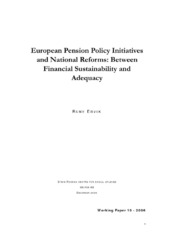| dc.description.abstract | The EU Open method of Coordination (OMC) represents one strategy for pension reform that ideally combines agreement on common objectives with different institutional and national approaches as means of reaching these objectives. This paper will focus on the OMC in pensions, seen as representing a pension policy discourse, and how it relates to national pension policy in three particular countries; two member states; Germany and the UK and one non-member country; Norway. Each of the three countries represents different welfare state and pension models, i.e. the Bismarck-, the Beveridge-, and the Nordic model respectively. Two key questions are addressed: Does the OMC process promote a particular kind of pension system model through its goal of providing adequate, sustainable and modernized pensions? How does it compare to and does it challenge existing national systems as found in the three selected cases in terms of their institutional and normative foundations? In addition the paper briefly discusses in what way the OMC in pension potentially impact national pension debates and reforms. The empirical material applied for analysis focuses mainly on the National Strategy Reports and the Joint reports by the Commission and the Council. Theoretically an institutional perspective is followed stressing the interaction between different institutions of pension provision and the adhering discourses surrounding these institutions. Thus, institutions are seen as instruments for solving problems (for instance income security in old age) and at the same time they are expressing a normative content inherent in their specific solutions. In this way each pension pillar (seen as an institution) contains its own more or less particular discourse. This paper distinguishes between three particular discourses: Social right-, status security-, and a private pension discourse. Analysing the OMC pension discourse as laid out in the Joint reports, the following key elements are identified: Firstly, the issue of financial sustainability takes precedence over the goal of adequacy. To obtain sustainability there is a need to raise employment rates and to stem growth in public pension expenditures. Secondly, this argumentation implies a new division of pension pillars by increasing the role of occupational and private pensions. In addition, it entails internal normative changes of pension pillars by strengthening traits known from private pension insurance. Thirdly, the goal of adequacy is shaped by the financial sustainability discourse and its focus on public pension expenditures. Fourthly, seen as a pension model the OMC on pensions promotes a hybrid model of pension provision containing elements from all three pension systems, but with the important qualification that it is really «hybridization with a bias». This means that the model represents a new pension blend that contains fewest traits from the Bismarckian model and with more prominence to elements known from multi-pillar systems as well as minimum pension guarantees as found in the new postreform Nordic model. From this follows that this hybrid pension model has various implications in terms of challenges to national paradigms: In the German case we find a clear move away from public first pillar provision and increasing reliance on second and third pillar provision. In addition, focus on minimum security challenge the status security orientation of the German system. For the UK there is no confrontation in terms of financial sustainability, implying a continuance of the tradition of pension privatisation, and providing a complex system of means tested benefits to secure minimum security. For the Norwegian case the hybrid OMC paradigm represents a challenge in terms of increasing reliance on occupational pension provision in providing standard security and by containing future public pension spending. | en_US |
